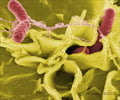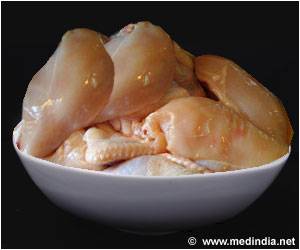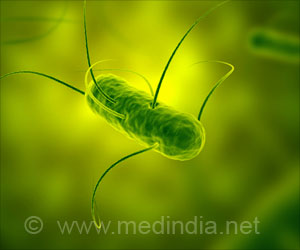A study reveals that Salmonella uses gut bioelectricity to navigate and invade the body, potentially opening new doors for understanding and treating chronic gut diseases.
- Salmonella uses bioelectric signals in the gut to find weak spots for infection
- The bacteria target specific areas like the FAE using this electric guidance
- This discovery could lead to new approaches in preventing and treating chronic gut disorders
Gut epithelial electrical cues drive differential localization of enterobacteria
Go to source).
Recent research conducted by a team at UC Davis Health has uncovered a novel mechanism that these pathogens use to navigate and breach the gut’s defenses, shedding light on how they find entry points to infect the body. This groundbreaking study, published in Nature Microbiology, explores the role of bioelectricity in guiding bacteria like Salmonella to these vulnerable areas.
Salmonella can sense and follow electric signals in your gut to find entry points for infection. #guthealth #medindia #salmonella’
Challenge of Bacterial Invasion
Every year, Salmonella causes approximately 1.35 million illnesses and 420 deaths in the United States alone. For these bacteria to infect a host, they must cross the gut lining, a task that involves overcoming a multitude of protective barriers. Upon entering the intestines, Salmonella faces a daunting environment filled with over 100 trillion commensal bacteria. Yet, they succeed in finding weak points in the gut lining where they can infiltrate and cause infection.New Discovery: Bioelectricity in the Gut
The research team at UC Davis Health, led by Yao-Hui Sun, a scientist affiliated with the Departments of Internal Medicine, Ophthalmology and Vision Science, and Dermatology, focused on understanding how Salmonella navigates the gut’s complex structure. Their study revealed that Salmonella detects bioelectric signals within the gut, which guide them toward specific areas where they can enter the body. This process, known as galvanotaxis or electrotaxis, is a type of cell movement in response to electric fields.The gut epithelium, which lines the intestines, consists of different types of cells, including absorptive enterocytes and M cells (Microfold cells). The latter are part of the follicle-associated epithelium (FAE) and play a crucial role in the immune system by sampling antigens. The study found that Salmonella bacteria are attracted to the electric fields present in the FAE, allowing them to target this area as an entry point into the host.
Differential Responses of Bacteria to Bioelectricity
Interestingly, the study also observed that not all bacteria respond to bioelectric fields in the same way. While Escherichia coli (E. coli), a harmless strain, tends to cluster near the villi in the gut, Salmonella is drawn to the FAE. This suggests that Salmonella specifically exploits the bioelectric field configuration in the gut to its advantage, bypassing other areas and focusing on the FAE to invade the host.Chronic Diseases and Bioelectric Guidance System
The discovery of this bioelectric guidance system not only advances our understanding of bacterial infections but also has potential implications for chronic conditions like Inflammatory Bowel Disease (IBD).IBD is believed to be caused by an abnormal immune response against commensal bacteria, and this study raises the possibility that abnormal bioelectric activities in the gut could be linked to the development of such diseases. Further research could lead to new strategies for preventing and treating bacterial infections and chronic gut disorders.
This highlights a previously unknown aspect of bacterial pathogenesis, emphasizing the role of bioelectricity in guiding pathogens to their target sites in the gut. As researchers continue to explore this new frontier, the findings could pave the way for innovative approaches to combating bacterial infections and managing chronic gastrointestinal diseases.
Reference:
- Gut epithelial electrical cues drive differential localization of enterobacteria - (https://www.nature.com/articles/s41564-024-01778-8)
Source-Medindia












